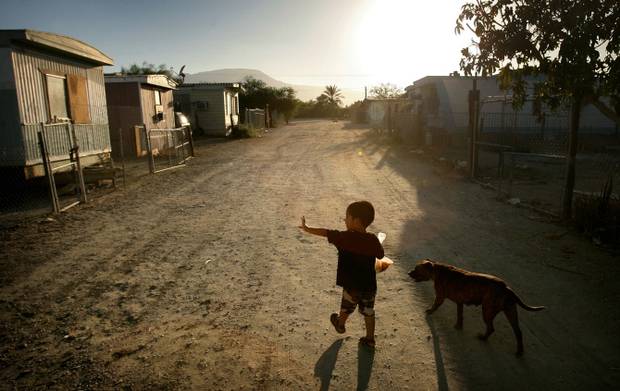Shock. Squalor. Solutions

I’ve been working in some of the worst slums in the world on and off for a couple of decades, so when James Schaffer and I visited two trailer settlements in Southern California’s Coachella Valley last week, I did not expect to be horrified.
It turns out my nonchalance was misplaced.
The squalor, injustice, and lack of opportunity that we observed was stunning–especially in light of their proximity to some of the lushest resorts, equestrian centers, and second homes on earth, in Palm Springs and La Quinta.
James and I were in the Coachella Valley to learn about one of the projects of a new client, Kounkuey Design Initiative (KDI). KDI helps local people in poor communities in Haiti, Africa, Colombia, and California to create ‘Productive Public Spaces.’ Generally this involves a crucial year-long process during which a community: identifies a wasteland, often containing trash and toxins, for redevelopment; decides what productive features they need; identifies the key contributors and stakeholders.
The result is a mixed-use space that might contain clean water supplies, classrooms, market gardens, market stalls, play areas, bridges, and critical open space. That’s the ‘output.’ The impact is the magic. Architecture and design can create economic, social, and environmental change, we are learning. Gardens can not only create good health in the community but also cash crops; classrooms create learning opportunities that are necessary to a growing local economy; play structures help create healthy children, who might otherwise be trapped inside or playing on toxic garbage heaps. Healthy children learn better, and contribute to economic productivity in the future. We could go on.
But back to Coachella. Five days on, we are still feeling a bit rattled by the conditions in which our neighbors are living. We’ve driven past these trailer parks in the past without giving them a thought, you see. We didn’t know there was no fresh water, no way to walk anywhere, no way to access fresh food or safe places to gather and play. We didn’t know the people who were harvesting our carrots and tomatoes and dates were living in uninsulated tin boxes sitting on top of their own sewage in temperatures that reach 115F regularly. We didn’t know that when they turn on their taps what comes out is damp, arsenic laced sand.
Now we do.
This was our first of many working visits to this project, and we are just now grasping the issues, understanding the solutions KDI is bringing, and meeting some of the residents. More to come.
Recent Posts
- Our Search Division is Ramping Up to Meet Increasing Demand for Talented, Purpose-Driven Executives
- 2020 Demanded Smart Strategies From Every Organization – Here’s What We’ve Been Working On
- S&C supports major new alliance in apparel industry
- Call it What it is: Power
- Schaffer&Combs places Higg Co’s incoming Vice President, Marketing & Communications and Senior Manager Sales
Recent Comments